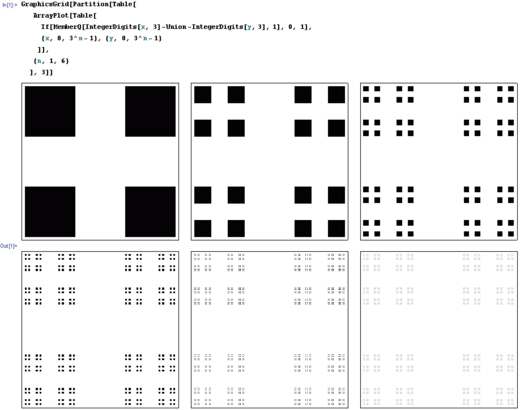0708-1300/Class notes for Thursday, October 11: Difference between revisions
No edit summary |
No edit summary |
||
| Line 9: | Line 9: | ||
---- |
---- |
||
Observe that in the first step figure the condition holds ( |
Take an arbitrary diagonal line intersecting the figure. Observe that in the first step figure the condition holds (the diagonal line intersects the black squares). Observe now that when moving to the second figure the given line will intersect a black square too. This means that if a diagonal line intersects the black set then it will intersect the set of the next step. |
||
Observe now that when moving to the second figure the given line will intersect a square too. This means that if a diagonal line intersects the black set then it will intersect the set of the next step. |
|||
Since in each step the set is self similar i.e. in each quarter of the square you have the black set of the previous step, then the intersection point of the diagonal line is contained in the same quarter of the previous intersection. Since this |
Since in each step the set is self similar i.e. in each quarter of the square you have the black set of the previous step, then the intersection point of the diagonal line is contained in the same quarter of the previous intersection. Since this quarters are nested and the diagonal of the quarters tents to zero, the sequence of intersection form a convergent sequence which converges inside the square (which is compact) and inside the segment of the line inside the square (which is compact too). Since the Cantor set is closed the limit point is in the Cantor set. It is inside the line segment as well. |
||
'''QED''' |
'''QED''' |
||
Revision as of 09:40, 11 October 2007
| ||||||||||||||||||||||||||||||||||||||||||||||||||||||||||||||||||||||||||||||||||||||||||||||||||||||||||||
The Cantor Aerogel
Strange as it may seem, the faded and barely visible Cantor aerogel in the square at the bottom right of the image above is still thick enough to block all diagonal light rays.
Proof:
Take an arbitrary diagonal line intersecting the figure. Observe that in the first step figure the condition holds (the diagonal line intersects the black squares). Observe now that when moving to the second figure the given line will intersect a black square too. This means that if a diagonal line intersects the black set then it will intersect the set of the next step.
Since in each step the set is self similar i.e. in each quarter of the square you have the black set of the previous step, then the intersection point of the diagonal line is contained in the same quarter of the previous intersection. Since this quarters are nested and the diagonal of the quarters tents to zero, the sequence of intersection form a convergent sequence which converges inside the square (which is compact) and inside the segment of the line inside the square (which is compact too). Since the Cantor set is closed the limit point is in the Cantor set. It is inside the line segment as well.
QED

